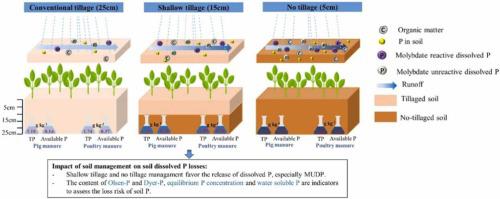Soil and Tillage Research ( IF 6.5 ) Pub Date : 2022-03-08 , DOI: 10.1016/j.still.2022.105353 Xuemei Chen 1, 2 , Wen Zhang 1 , Gérard Gruau 3 , Ewan Couic 3 , Patrice Cotinet 4 , Qingman Li 2

|
It is well established that shallow tillage (ST) and no-tillage (NT) of cultivated soils can have higher risk of dissolved phosphorus (P) loss during runoff than conventional tillage (CT). However, quantitative descriptors of how differences in tillage practices influence soil P sorption properties and how these properties in turn influence dissolved P loss remain lacking. Moreover, the influence of tillage practices on the forms of dissolved P, particularly molybdate unreactive dissolved P (MUDP), has rarely been investigated. Thus, we simulated runoff using pilot soils that had experienced three tillage practices (CT, ST, and NT) and two types of fertilization (pig and poultry manure) for 20 years. The results indicated that shifting from CT to ST or NT changed the soil’s capacity to bind P and increased Olsen-P, Dyer-P, equilibrium P concentration (EPC0), water soluble P (WSP), and the degree of P saturation (DPSOX). The experiment confirmed that switching from CT to ST or NT could increase P loss during runoff. The increase was evident for the two fertilizations (pig manure and poultry manure) with an amplified effect for the poultry manure modality. Switching from CT to ST or NT increased the loss of MUDP, which again was higher for poultry manure fertilization, for which the percentage of MUDP increased to more than 40% of TDP. Correlations between the risk of dissolved P loss and risk assessment indicators were positive, but DPSOX was opposite predicted results to other indicators, indicating that DPSOX was not suitable for predicting the risk of dissolved P loss. Our results suggest that MUDP should be considered when assessing the risk of dissolved P loss when adopting ST and NT, since MUDP is bioavailable and thus can contribute to the eutrophication of surface water.
中文翻译:

保护措施改变土壤磷吸附特性和径流过程中溶解磷损失的组成
众所周知,耕作土壤的浅耕 (ST) 和免耕 (NT) 在径流期间比传统耕作 (CT) 具有更高的溶解磷 (P) 损失风险。然而,关于耕作方式的差异如何影响土壤磷吸附特性以及这些特性如何反过来影响溶解磷损失的定量描述仍然缺乏。此外,很少研究耕作方式对溶解磷形式的影响,特别是钼酸盐非反应性溶解磷 (MUDP)。因此,我们使用已经经历了 20 年的三种耕作方式(CT、ST 和 NT)和两种施肥方式(猪和家禽粪便)的试验土壤模拟了径流。结果表明,从 CT 转变为 ST 或 NT 改变了土壤结合 P 的能力并增加了 Olsen-P、Dyer-P、0 )、水溶性磷 (WSP) 和磷饱和度 (DPS OX )。实验证实,从 CT 切换到 ST 或 NT 会增加径流过程中的磷损失。两种施肥(猪粪和家禽粪肥)的增加是明显的,对家禽粪肥方式的影响更大。从 CT 切换到 ST 或 NT 增加了 MUDP 的损失,这在家禽粪便施肥中再次更高,其中 MUDP 的百分比增加到 TDP 的 40% 以上。溶解磷损失风险与风险评价指标呈正相关,但DPS OX与其他指标的预测结果相反,说明DPS OX不适合预测溶解磷损失的风险。我们的研究结果表明,在评估采用 ST 和 NT 时溶解磷损失的风险时,应考虑 MUDP,因为 MUDP 具有生物可利用性,因此可能导致地表水的富营养化。


























 京公网安备 11010802027423号
京公网安备 11010802027423号